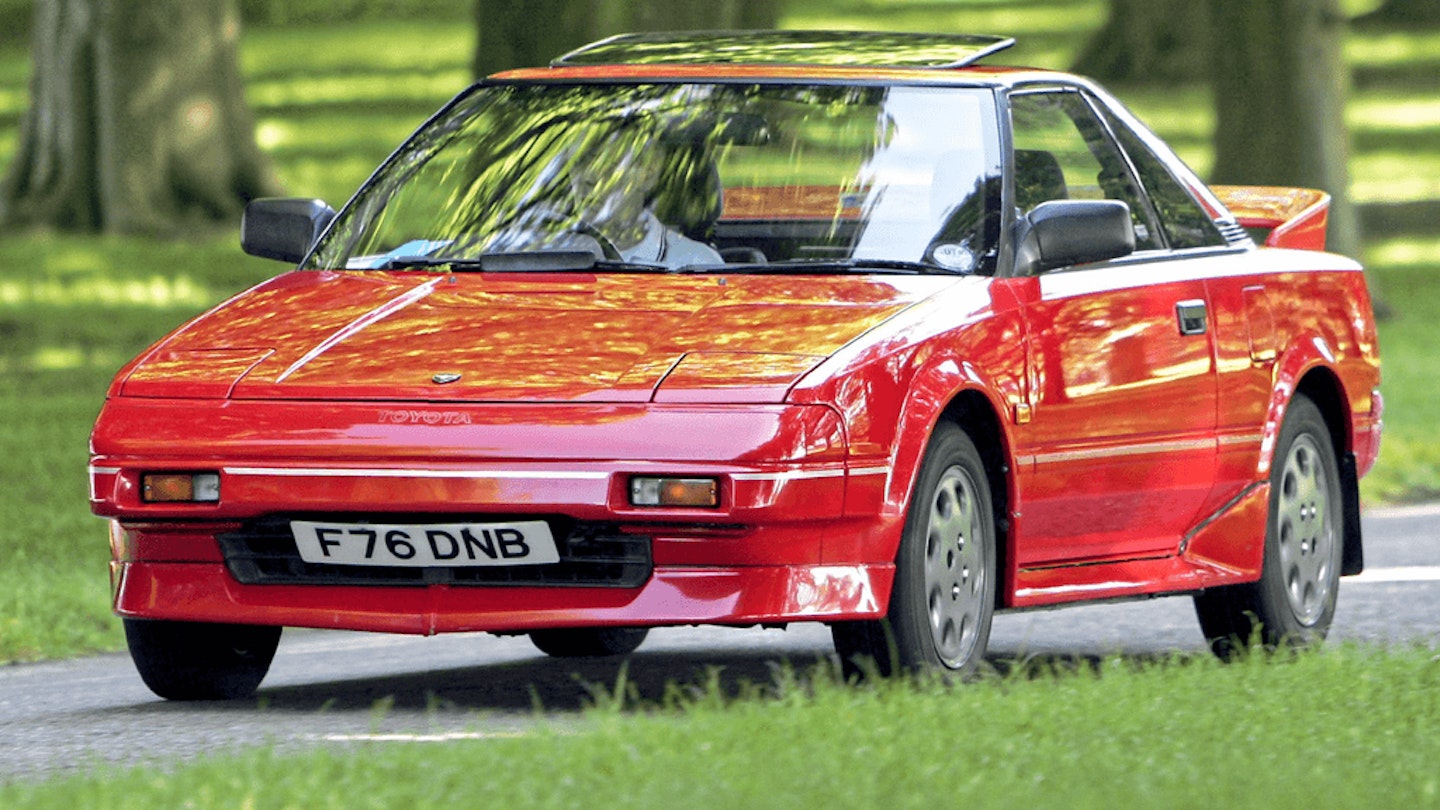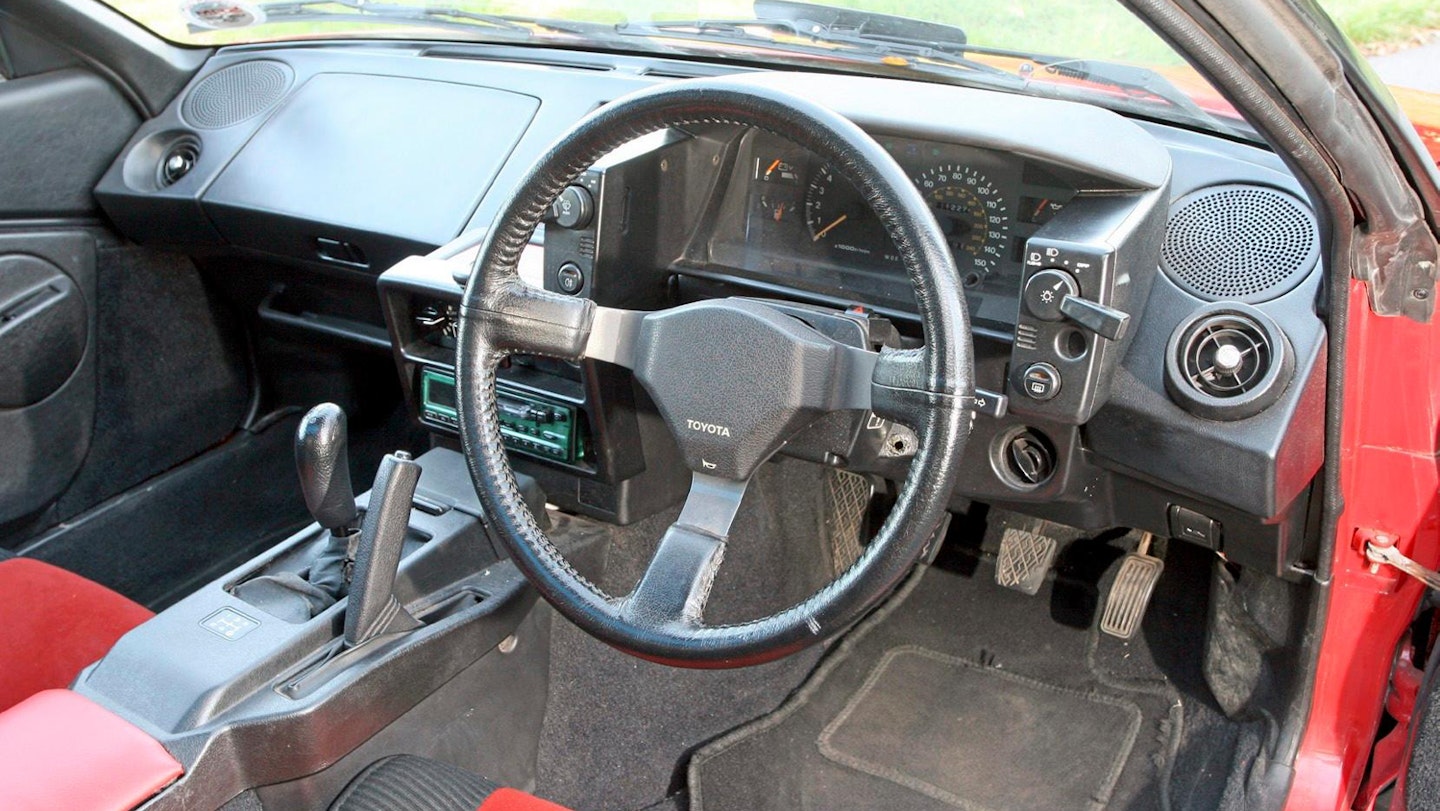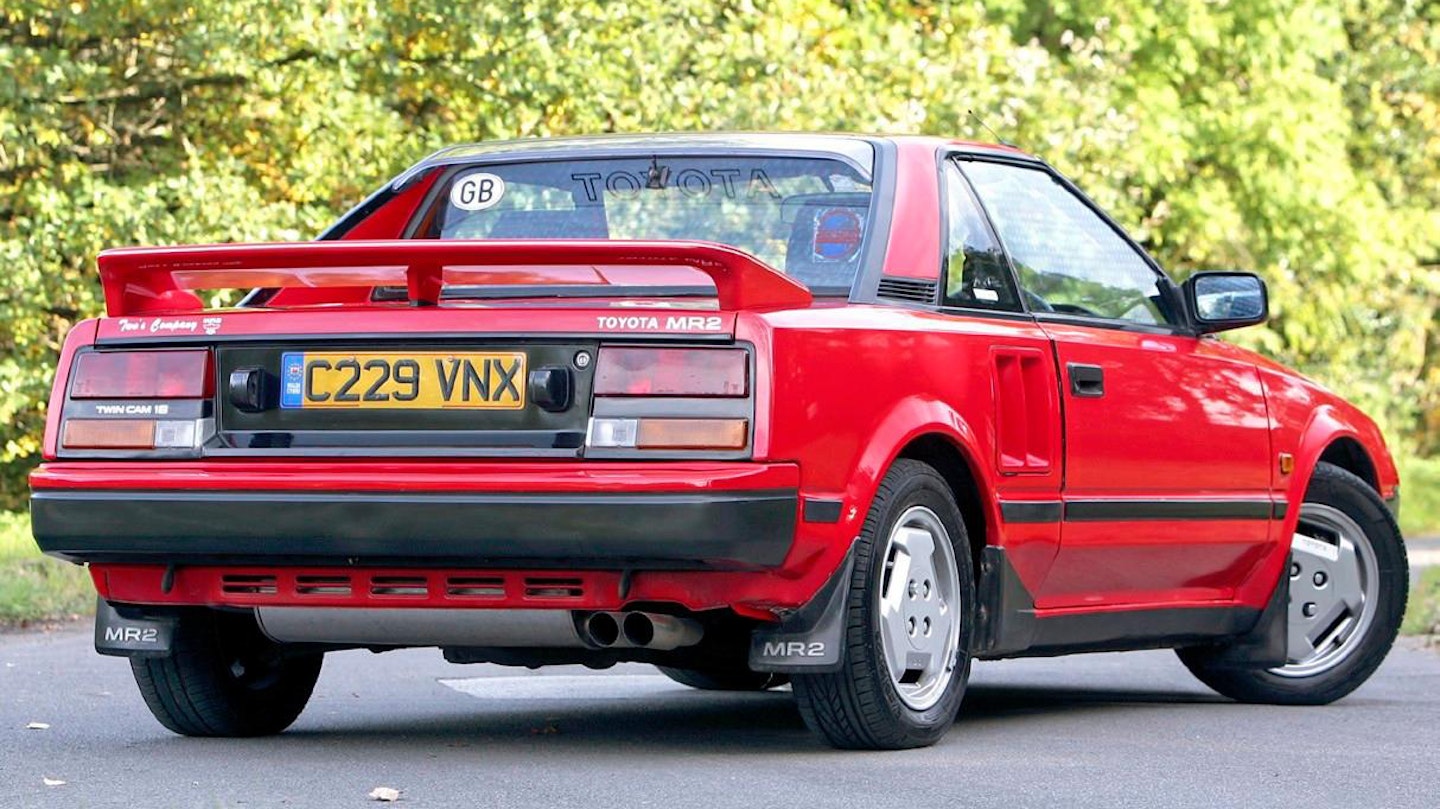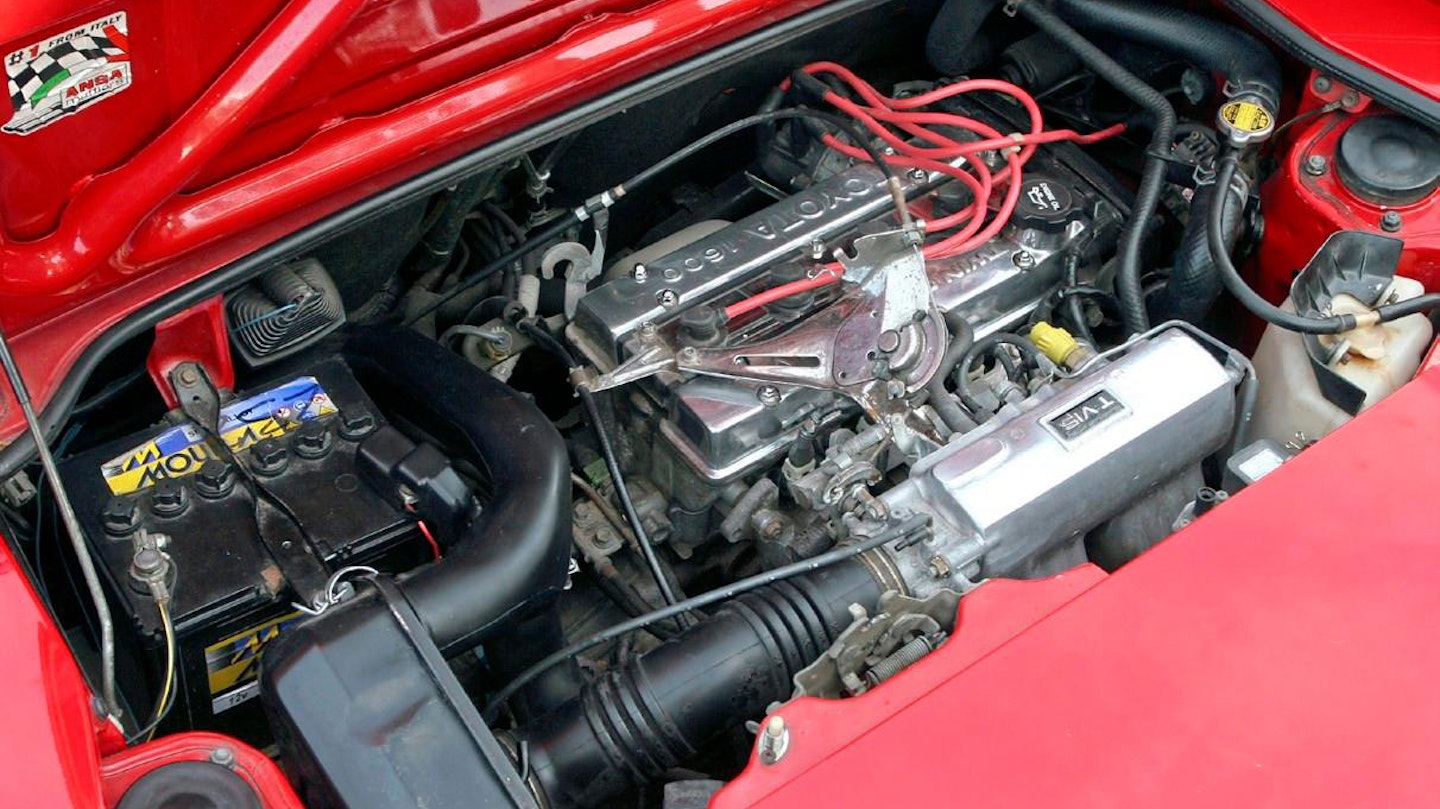WISE BUYER
Values of the ultimate Eighties sports car are rising, so here’s how to bag one now!

Well proportioned shape and neat lines still eye catching.
Why you want one
With the MGB, Midget and TR7 dead and the Alfa Spider and Fiat X1/9 showing their age, Toyota unveiled the MR2 to a delighted press and public in 1984. This perfectly proportioned car had the Eighties looks, exceptional packaging, peerless Toyota engineering, stiff body and road manners from the hand of Lotus engineer Roger Becker. More than 14,000 MkI models were built but, as you’d expect, the numbers dwindled thanks to Eighties rustproofing (or lack of).
Of the cars left, you’ll find there were three types sold in the UK. The MkIa was unleashed to UK buyers in 1985 with a twin-cam 1587cc four-cylinder engine that’ll rev to 7600rpm. All had a removable ‘moon roof’ that can be stowed in the nose, while a few early cars had two-tone paint. The MkIb was introduced in October 1985 with better brakes, a face-lifted interior and externally, a two-piece front splitter to counter high-speed lift, plus many other minor revisions. You may find one of the rare, supercharged models, but this will have been imported so look for the conversion from kph to mph on the speedo. Whichever you find, you’ll be welcomed with open arms by the likes of the MR2 Drivers Club, which organises a free, once a year, event that’s open to all.
The inspection
Check for corrosion in the rear wheelarches, where it spreads to the quarter valances. Missing rear mudflaps are a giveaway. The seam that runs across the bulkhead behind the spare wheel in the front luggage compartment rots on pre-1987 cars, as does the front valance; later MR2s got a plastic valance. Water can collect in the rearmost corners of the luggage bay behind the engine; removing the rubber bungs will let it drain. Replacing the bonded-in windscreen can lead to problems, because fitters often dig out the sealant and take the paint with it. If the car is a T-bar with leaking seals it’ll be even worse, so lift the carpets to check for holed metal. The inner front wheelarch liners – and on later versions the side skirts – can fill up with leaves which leads to rotten A-pillars. If the doors are creaking it’s caused by worn door stay pins, which are easily cured by rotating the pin through 90 degrees.
MARKET ANALYSIS
Rusty projects in need of total restoration can be bought for around a grand, while nicer project cars will cost a grand or so more. To put that in perspective, a 1987 car in need of TLC sold for £2650 at Barons in October last year, while two others were auctioned through Mathewsons in November – a 1989 MR2 in the same family for 30 years for £2200, and a 1988 model in original condition but in need of revival for £3870. Roadworthy cars in better condition can be had for around £5000, it seems, but you’ll pay substantially more for a minter. Then there’s the supercharged MR2 – one of which in good order was snapped up for £9180 at Anglia Car Auctions last summer.
Check that all the bungs are in the various holes on the underside of the chassis, especially under the footwells and seats, because water can enter here through damaged underseal and go undetected beneath the carpets. The inner bulkhead can rot and then leak. If the corrosion is on the passenger side it can be repaired by removing the glovebox and lower dash panel, but on the driver’s side the whole dash must be removed, which is why repairs at a specialist will cost at least £300. The front bumper reinforcement bar corrodes so squeeze the bumper moulding where the indicators are mounted – problems there could give you headaches or cost around £500 to put right by your friendly welder.

Cabin is snug, but nicely made and full of Eighties charm.
Engines can last 150k miles, or more if looked after. This means cleaning the injectors every 12k miles and changing oil every 6k. The cambelt should’ve been changed within the last five years or 60k; if you don’t want to do it, it’s a £250 job. The main engine problems occur from blown cylinder head gaskets because of weak or poor-quality coolant; check the level in the white plastic expansion tank towards the rear of the engine bay. Also check the tank’s cap because they can crack, allowing air into the system. The cooling system has long pipe runs from the back to the front of the car; coolant changes on a non-level surface can lead to air locks that fool the various temperature sensors, causing idling revs to fluctuate between 600rpm and 2000rpm. A high idle after initial warm up suggests a worn idle-up valve – an electrically operated air solenoid on the input air piping that connects an air pipe to bypass the throttle body and permits a small amount of extra air into the engine when cold; replacement used valves cost £40. The oil pressure should read in the top third of the scale with the engine running above 2000rpm. The engine ECU can pack up and new ones are hard to source, but used replacements are £50. They are not interchangeable from MkIa to MkIb.
Transmissions on all UK-market MR2s were five-speed manuals that can suffer from worn synchromesh on second gear. At around 100k miles slack develops in the selector mechanism, which initially leads to excessive movement of the gearstick in top gear and develops into jumping out of fifth gear. The clutch is controlled hydraulically and if it seems to be juddering when you’re changing gear, you’ll have to bleed the system before fitting a new clutch plate.
‘One of the most satisfying sports cars ever made’

Look for rot! Missing mudflaps suggest rusty rear arches.
Dampers last around 70k miles; adjustable or non-adjustable units can be bought for the same £100 per corner as the originals. A knocking noise from the front when the car is driven over uneven surfaces suggests worn anti-roll bar drop links or tired steering rack bushes. Both are relatively easy replacements for the home mechanic – OE parts cost about £25 per side. Meanwhile, brakes are discs all round. Front discs were initially undersized but from October 1985 larger units were fitted that are less likely to warp, although 30k miles is the most you can expect. The rear calipers can seize because of worn handbrake cables and/ or worn seals, but they’re an easy DIY rebuild, and an official repair kit is under £80. Alternatively, exchange-rebuilt units cost around £100 each, while handbrake cables are £60 a set.
Inside, late T-bar cars came with perforated leather upholstery that cracks if neglected, while the ashtray on post-1986 cars has a lid that’s prone to snapping off. T-bar MR2s can suffer from compressed sealing rubbers, which leads to water leaks in the cabin. New seals cost £260 per set, but can be tricky to fit. The nylon cogs for the electric windows can strip. Replacements are £25, although a whole regulator mechanism might be required if the main cog has stripped. The driver’s side window switch is prone to failure which may leave you stuck with the window down. Pop-up headlight motors are reliable though! ■

MR2 sensitive to neglect, so fresh oil and coolant is vital.
WHAT TO PAY
PROJECT £1000
GOOD £2500-£6000
EXCELLENT £6000-£10,000
TECH SPEC
Engine 1587cc/4-cyl/OHC
Power 122@6600rpm
Torque 104lb ft@5000
Gearbox 5-speed manual
Top speed 124mph
0-60mph 7.7sec
Economy 35mpg
WHAT WE SAY THE ONE TO BUY

Danny Hopkins Editor
The two MkIs I owned – a ‘T-bar’ and ‘moon roof’ – could only have been designed by an enthusiast, for the enthusiast. The steering and handling turned every drive into a computer game joyride and the TVIS (Toyota Variable Induction System), where the ECU opens extra induction valves above about 4200rpm, is absolutely bonkers genius and made me laugh out loud each and every time.

Matt Tomkins Workshop editor
There’s nothing quite like the jet-like whine of a supercharger, particularly one that’s just inches from your head as it is in the mid-engined MR2. To get one, though, you’ll be looking at a rare import model, so expect the speedometer to read in kph, unless it’s been converted. Also ensure that if speed restriction devices and warning alarms have been removed, that it’s all been done properly.

James Walshe Deputy ed
The small sports car may well prove to be a thing of the past in the next few years, as nobody apart from Mazda is building them nowadays. This makes a little vehicle like the MR2 a precious thing. There’s so much sense to smallness, which gives you more efficiently delivered performance, better economy and handling and lower costs. Buy any kind of small roadster and maybe they'll make a comeback!
USEFUL CONTACTS
MR2 Drivers’ Club, mr2dc.com
MR2 Owners’ Club, mr2oc.co.uk
MR2 Mk1 Club, mr2mk1club.com
T&N Car Parts, tandnmr2mk1carparts.com
Toyota MR2 Mk1 Spares, mr2mk1toyotaspares.com
Subscribe to a PC Print+ Subscription today and you'll get instant digital access PLUS FREE UK delivery so you'll never miss an issue again. Check out our offers today.
